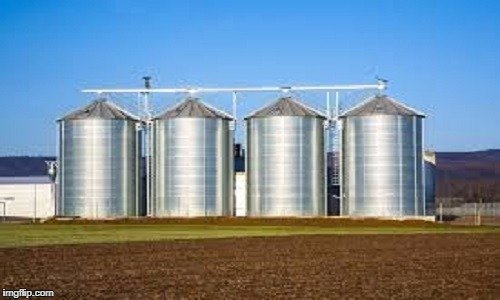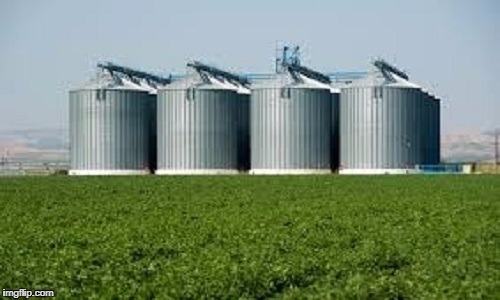Grain elevators
Silos, or rooms for storing and preserving food, have been used in one way or another in various countries since very early. In France and Spain, and in other parts of Europe, the grain was preserved in the trenches, dug in the ground, at the time of Pliny, which mentions in some of its writings that "the best plan of preservation Of the grain is to place it in the trenches dug in a dry soil, called Iris, as in Cappadocia, Thrace, Spain and Africa. This method of preserving grain was not confined to the East, as at the time of Columbus' discovery of America, the natives used to store grain in the pits and some tribes continue practice 'actual hour. The ancient Egyptians, as we learned from Scripture, stored enough grain in the seven years of abundance to serve themselves and other nations during the seven years of famine that followed. The Egyptian silos were evidently of a more improved and more permanent nature than the gross trenches mentioned above, as "Vilkinson in his work.

The ancient Egyptians, "says that" some of the rooms in which they housed the grain seem to have had vaulted roofs. These were: filled through an opening near the summit, to which the men ascended by steps, and the grain, if desired, was taken out of a door at the base. "It is important to note that the first silos were mainly used for the conservation of corn and other dried cereals for indefinite periods, such as years of abundance to years of shortage, and there are cases where The corn has been kept in good condition for a long period of 200 years. On the other hand, Silos nowadays are more particularly used for the storage of green forages, to feed livestock during the winter or for one year at However, foodstuffs stored in this way can be kept indefinitely, air is not allowed to enter the silo, so it is important that the sides and floor are perfectly watertight and it is The sides are smooth and vertical, so that the silage can be fixed uniformly and compactly, leaving no vacant space Accumulation of air Sila Ge is the name given to a reserve alime Green and succulent in a silo, either in uncut form, or after passing through a cutting machine and reduced to a small piece. Once it is filled in fermentation the silo begins, which increases the temperature and expels the air. Subsequently, the chemical change ceases, and the resulting product is mild. Silage that can be kept indefinitely if the air is not allowed to enter the mass. The temperature required to produce this result is about 1220 F., and if for any cause such as excess moisture in the plant, or excessive cold, the temperature does not reach this height, the acid ferments Will not be destroyed, and the resulting product is a sour silage, less palatable and less valuable than the other. During the fermentation process, the gases are generated to a large extent, and the top of the silo must be sufficiently open to allow them to escape. Once the silo has been filled, it is possible that the air can not enter the silage at great depth by covering it with less valuable material or sailcloth. Another method that is both cheap and effective is to sow grain, such as oats, on top of the silage, pouring water on it.

The word "silo", taken from the Greek, Silos, a pit for preserving grain, is the name now applied to any airtight chamber formed for the preservation of either dry grains or green food. It can simply be a trench trench hung on the ground in any dry position, in which the silage is filled and weighted with boards, earth or other materials. More often, it is a structure of wood, metal, brick, stone or other building materials, or a combination thereof, built entirely above the ground or extending to A few feet, either standing alone or forming part of the other agricultural buildings. The origin of the structural silos on the modern plane is a very recent date, but the progress of the solo was so rapid and successful - in America at least - that in the short period of thirty years more than one hundred thousand silos Were built in the United States alone, and the number is constantly increasing. In form, the silo can be constructed square, rectangular, octagonal or circular on plan. 1 form of a pattern of buildings, its shape would probably be decided by the position it occupied and the space available, but if only one form could be adopted at will. The round silo is more favorable to the uniform and compact decanting of the silage due to the absence of corners and, therefore, more favorable to its perfect preservation. On the other hand, it does not integrate with other buildings so easily as a square or rectangular silo, without loss of space, and for this reason, they are probably more often constructed. The same remarks would also apply to octagonal silos. If one stands alone, however, no objection can be raised to the round or octagonal shape of the silo, and since the proper conservation of the silage is the main object to be attained, one or the other of These forms should be adopted in preference to the others.
The main objection to square or rectangular silos is the presence of corners that prevent the silage from settling in a uniform and compact manner, resulting in loss of space and undesirable air accumulations. This defect can be repaired to a large extent by ensuring that the corners are well rounded. Of the two, the square silo is perhaps the best shape, and probably a little cheaper than a rectangular of equal capacity, because the wall space is rather inferior.
When a large quantity of silage is required, it is advisable to store it in two or more silos of moderate size, preferably a very large one, with very large silos. food; And, if the height is increased to alter the dimensions of the surface beyond a reasonable limit, excessive work is involved in the work. The height above the ground should not exceed 20 to 25 feet, and the depth below the ground should not exceed 5 or 6 feet, the limit from which a man can easily lift the forage. With rectangular silos, difficulty can be avoided by having one or more partitions dividing the silo into two or more square or nearly square compartments. Irrespective of the shape adopted for the silo, it must always be constructed with a capacity greater than that required, since a considerable reduction must be mutilated for waste from sanitation and ensilage silage. Even if the material is added a second or third time, there will still be some amount of space lost to be allowed. A fifth is considered a low estimate for the loss of space and the ensiling of waste.

To determine the size of the silo required to maintain food for a number of cattle over a period of time, 40 Ibs may be considered as the average amount of silage needed to feed one animal per day and 40 Ibs may also be considered Be considered as the average weight of one cubic foot of silage. Therefore, if the number of animals is multiplied by the number of days they are to be fed, the result will be equal to the number of cubic feet of silage space required. Assuming 30 animals are to be fed for six months, or 184 days, the total amount of space required would be 30 x 184 = 5,520 cubic feet. To find the number of cubic feet in a square or rectangular silo • multiply the length in feet by the width and then the height, and the result will give the total cubic feet. For example, if a square silo is 14 feet long and 25 feet high, the cubic content would be 14 feet x 14 feet x 25 feet = 4,900 feet. In the case of a round silo, multiply the diameter square in feet by height and then .7854. For example, if a round silo measures 14 feet in diameter and 25 feet in height, the cubic content would be 14 feet x 14 feet x 25 feet x .7854 = 3,848 feet. With regard to the position, the silo should be placed as close as possible to the feeding center to minimize the work of transporting food to the different eaters. In round or octagonal agricultural buildings, such as common in America, the silo usually takes the same form as the main building, and is placed in the center, where it occupies a convenient position to feed the various animals stuck around the building. In the accompanying plate, a circular silo is shown at one corner of the main building, where it proves not only a useful assistant but also a very nice feature. A practical arrangement is to have the doors of the silo opening in a passage, or in the feed store or mixing room, which usually occupies a central position. A saving in the cost of erection can often be achieved by using one or more of the walls of the main building in the construction of the silos.
Images source:https://imgflip.com/memegenerator
This post received a 2.1% upvote from @randowhale thanks to @naijasteemit! For more information, click here!
This post has received a 2.31 % upvote from @booster thanks to: @naijasteemit.
Congratulations @naijasteemit! You have completed some achievement on Steemit and have been rewarded with new badge(s) :
Click on any badge to view your own Board of Honor on SteemitBoard.
For more information about SteemitBoard, click here
If you no longer want to receive notifications, reply to this comment with the word
STOP